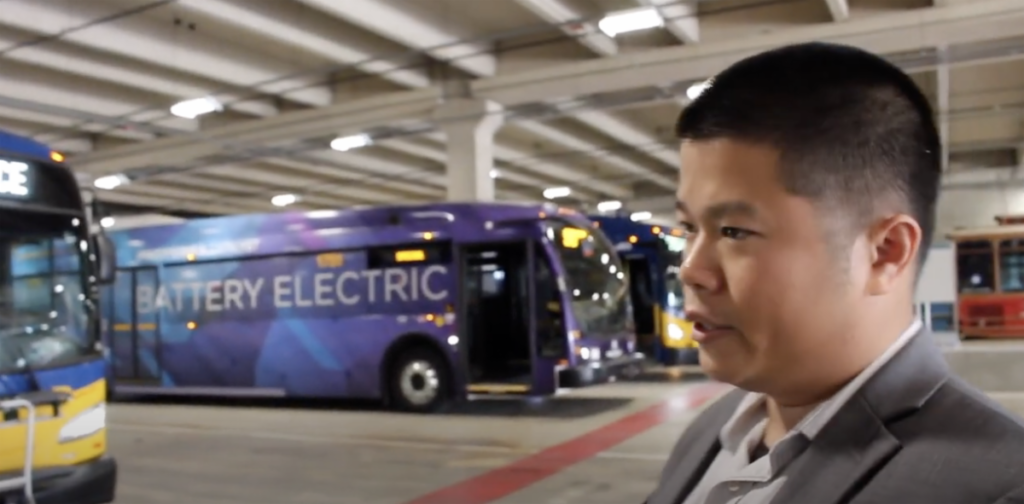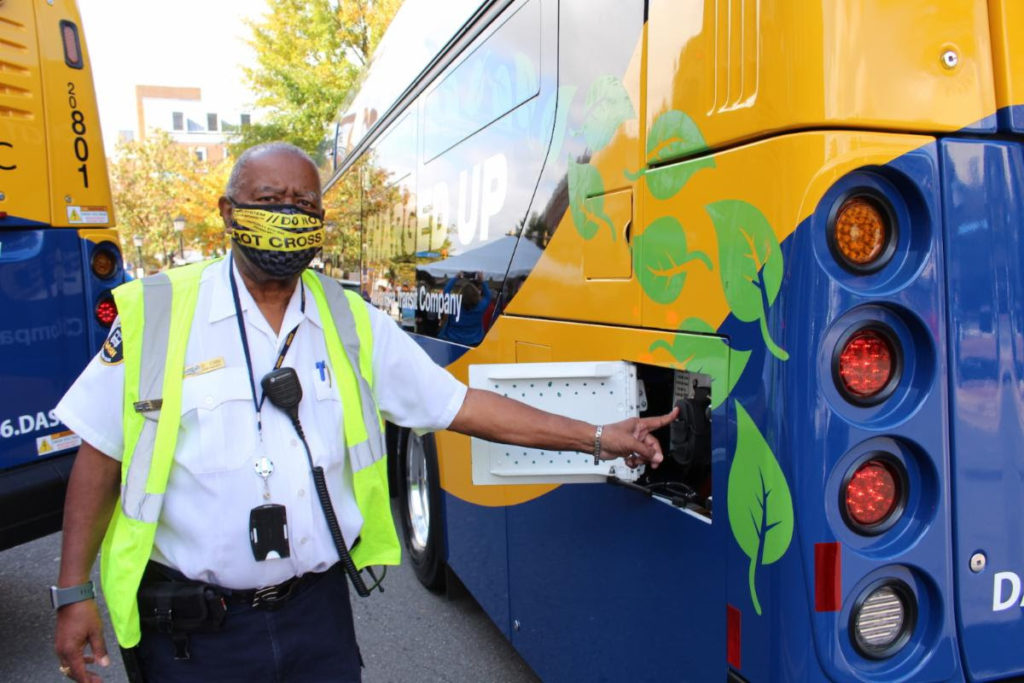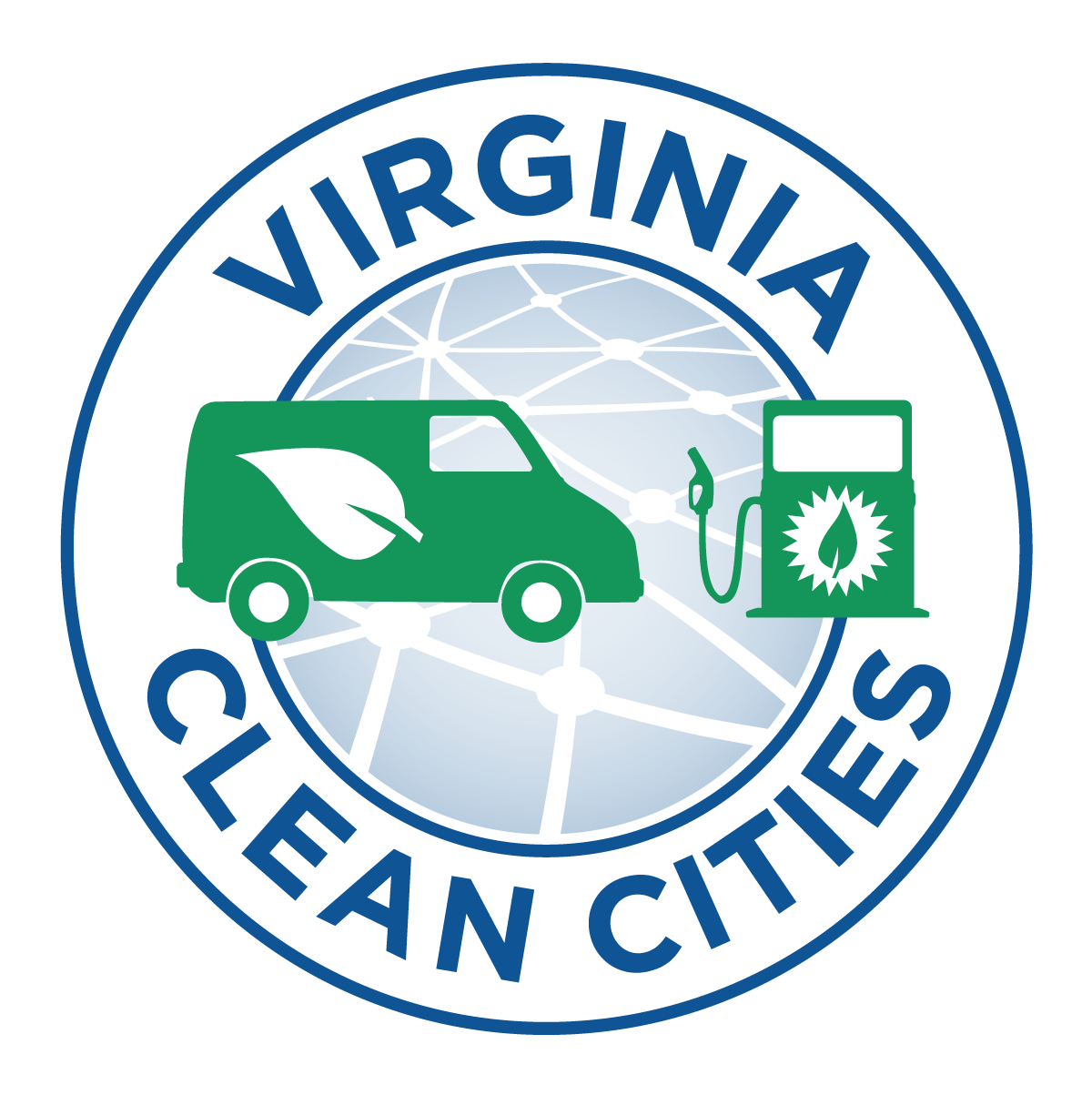In December 2020, Virginia Clean Cities (VCC) hosted the webinar “Electric Transit Buses in Virginia: A Virtual Site Visit” to showcase the Alexandria DASH (Alexandria Driving Safely Home) facilities and their new electric buses. The webinar began with the introduction of the facility and the Commonwealth’s progress towards alternative fuel vehicles by VCC Executive Director Alleyn Harned and the General Manager of the Alexandria Transit Company Josh Baker. Guest speakers Angela Conroy of the Virginia Department of Environmental Quality and Clinton Edwards of the Virginia Department of Rail & Public Transportation provided background information on the efforts in Virginia.
A new video site tour of Alexandria DASH’s indoor facility and new electric buses was shared with attendees. In the video, an extensive tour of the facility was led by DASH’s Assistant General Manager Raymond Mui. The tour showcased the incorporation of the six new battery-electric buses into their fleet.

At this time, their facility houses a mixed fleet of traditional diesel, clean diesel, clean diesel hybrid, and battery-electric buses but DASH’s goal is to scale up to a zero-emission fleet by 2035. The tour featured a conversation with one of their bus drivers, and she shared the benefits of the new electric technology. The video also highlighted Governor Northam’s speech at the unveiling of the electric transit buses in October 2020. If you are interested, you can watch Governor Northam’s full speech here.
If you were unable to attend the webinar or would like to watch the site tour again, the video can be found on VCC’s YouTube page linked here.
Resources for Local Governments and Fleets
- Virginia DEQ public electrification projects announcement
- Virginia VW Settlement Agreement information
- U.S. DOT Low or No Emissions Vehicle Program offering federal funding of up 85% of the cost of an EV bus.
- Making Efficient and Responsible Investments in Transit (MERIT) is the Virginia Department of Rail and Public Transportation’s statewide public transportation grants program.
After the conclusion of the video tour, the guest speakers took questions from attendees.
Have you learned anything during this process that you would like to share with others looking to achieve similar accomplishments?
- Raymond Mui – One of my biggest experiences through this process that we are all still going through is a lot to learn. Everyone should expect to learn something new every single day. There shouldn’t be an expectation, or no one should feel like they aren’t up to task because they don’t know anything or because they don’t have all of the answers. We have spent a lot of time and resources and as we’ve completed a zero-emissions fleet feasibility study, we have now kicked off and have started on our way on our zero-emissions bus implementation plan. And as we’ve seen, we have six chargers and six buses with eight more on the way.
- Clinton Edwards – If an agency is looking to move forward with the one battery-electric they need to be engaging with their utility provider very early on. Many agencies across the country receive sticker shock when they receive their first bill from their electric company for demand charges and they weren’t prepared for that increase. So just engage with time and make sure that the facility has enough power to be able to do all the basic core functions, including adding any electric chargers.
- Josh Baker – One of the important things that we have learned from our process of understanding right off that base was what our facility can handle and what it can not handle. And that has really paved the way and helped us lay out the framework for what we have accomplished so far and what we will need to figure out in order to get to our eventual goal of going 100% zero emissions.
During the tour charging demand management was mentioned, can you speak a bit more about that topic and the technologies or software involved?
- Raymond Mui – We very recently got our first six chargers and we are just now slowly launching into service our first three electric buses with many more on the way. It is our expectation that as we roll out our electric buses that there will be a point in time where we will need to start figuring out how to manage or optimize our charging practices and that goes hand in hand with managing and optimizing our logistics practices inside the garage. With our zero emissions implementation study, it is very likely that we’re going to have to explore some type of charge management system, especially with the diversity of charging technologies and manufacturers that we are involving in our zero-emission programs.
Is something like this project replicable in more rural locations?
- Clinton Edwards – I think for those in more rural areas, they would have to figure out how long they want the bus to be out on the street. One caution that I have heard is that if your base bus is out on a route from 5 a.m. to 11 p.m., you shouldn’t expect that same type of diesel equivalence with a battery-electric bus.
- Josh Baker – I would just add that we have seen pretty good range out of our electric buses. We are waiting to see what the cold weather does to them, but surprisingly very early on you know there is always range anxiety and that doesn’t seem to be as much of a problem as we originally had anticipated.
- Raymond Mui – I will just add to that based on my knowledge, a rural application is not necessarily a less ideal application for an electric bus. It depends on your service profile, as Josh mentioned, very frequent stop and go and also very frequent doors opening, especially in cold weather, presents a very challenging environment for eclectic buses. We see that currently with the performance of our electric buses because heat is not a natural byproduct of the diesel buses. So the new technology has many benefits but also has new challenges.
- Angela Conroy – All rural areas do not operate the same so there is no one size fits all solution. You don’t always need a 40 or 60-foot bus running in these areas. So one way we at DEQ are looking to facilitate the expansion of battery-electric technology in other areas of the state outside of our urban areas is to include smaller buses on our contracts.
Is there a state or regional charging standard for the buses? For example, could a DASH bus potentially use charging facilities in Fairfax?
- Alleyn Harned – It was noted in the video that J1772 CCS is that standard. It’s the North American standard for fast charging of electric vehicles and it goes all the way up to 350 – 450 kilowatt of throughput into a vehicle so it’s a pretty robust piece of equipment. That same equipment can be used as a depot charger for any facility across the bus markets so sticking with that standard for depot charging is key.
- Raymond Mui – One of our objectives is being able to demonstrate the industry commitments to standardizations as far as charge ports and charging technologies. One of the things that really gave us a lot of comfort and a lot of confidence and assurance to be able to move forward, especially with two different manufacturers was knowing that the industry has committed performance to a standardized charging technology. Ultimately, this gives the transit agencies and customers the ability to not be forced to put all their eggs in one basket and to be able to diversify which really applies to a fleet in transition in a way that works best for the agency.
If you need additional information about how you can add electric buses to your fleet, please contact Matt Wade.

